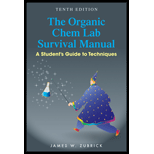
Concept explainers
Interpretation:
If someone has put about one-quarter of an inch of solid in the tube, should they go for an eye exam is to be explained.
Concept Introduction:
The melting point of a substance is the temperature at which it changes state from solid to liquid. This change occurs in atmospheric pressure and during melting point the two phases (solid and liquid) exist in equilibrium.
Nowadays in laboratory lots of equipment is available for determine the melting point of substance.
Put the correct amount of a solid in a melting-point tube.
Answer to Problem 1E
The person should carefully put the correct amount of sample in the tube.
Yes the person should go for an eye exam, if someone has put about one-quarter of an inch of solid in the tube due to weak eyesight.
Explanation of Solution
A melting point is the temperature at which the first crystal just starts to melt until the temperature at which the last crystal just disappears. Take melting points only on dry, solid substances, never on liquids or solutions of solids in liquids or on wet or even damp solids.
Use only the smallest amount that you can see melt because larger samples will heat unevenly. The person should carefully put the correct amount of sample in the tube.
Yes the person should go for an eye exam, if he/she has put about one-quarter of an inch of solid in the tube due to weak eyesight.
Want to see more full solutions like this?
Chapter 12 Solutions
The Organic Chem Lab Survival Manual: A Student's Guide to Techniques
- Steps and explanation.arrow_forwardProvide steps and explanation please.arrow_forwardDraw a structural formula for the major product of the acid-base reaction shown. H 0 N + HCI (1 mole) CH3 N' (1 mole) CH3 You do not have to consider stereochemistry. ● • Do not include counter-ions, e.g., Na+, I, in your answer. . In those cases in which there are two reactants, draw only the product from 989 CH3 344 ? [Farrow_forward
- Assign these protonarrow_forwardCould you please solve the first problem in this way and present it similarly but color-coded or step by step so I can understand it better? Thank you!arrow_forwardCould you please solve the first problem in this way and present it similarly but color-coded or step by step so I can understand it better? Thank you!arrow_forward

 Chemistry: The Molecular ScienceChemistryISBN:9781285199047Author:John W. Moore, Conrad L. StanitskiPublisher:Cengage Learning
Chemistry: The Molecular ScienceChemistryISBN:9781285199047Author:John W. Moore, Conrad L. StanitskiPublisher:Cengage Learning World of Chemistry, 3rd editionChemistryISBN:9781133109655Author:Steven S. Zumdahl, Susan L. Zumdahl, Donald J. DeCostePublisher:Brooks / Cole / Cengage LearningChemistry: Matter and ChangeChemistryISBN:9780078746376Author:Dinah Zike, Laurel Dingrando, Nicholas Hainen, Cheryl WistromPublisher:Glencoe/McGraw-Hill School Pub Co
World of Chemistry, 3rd editionChemistryISBN:9781133109655Author:Steven S. Zumdahl, Susan L. Zumdahl, Donald J. DeCostePublisher:Brooks / Cole / Cengage LearningChemistry: Matter and ChangeChemistryISBN:9780078746376Author:Dinah Zike, Laurel Dingrando, Nicholas Hainen, Cheryl WistromPublisher:Glencoe/McGraw-Hill School Pub Co Living By Chemistry: First Edition TextbookChemistryISBN:9781559539418Author:Angelica StacyPublisher:MAC HIGHER
Living By Chemistry: First Edition TextbookChemistryISBN:9781559539418Author:Angelica StacyPublisher:MAC HIGHER





